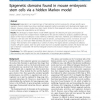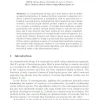680 search results - page 75 / 136 » Genomic computing: explanatory modelling for functional geno... |
ISMB
1997
13 years 10 months ago
1997
Protein chimerism is a phenomenon involving the combination of multiple ancestral sequences into a single, multi-domain protein through evolution. We propose a novel method for de...
BMCBI
2004
13 years 8 months ago
2004
Background: For the purposes of finding and aligning noncoding RNA gene- and cis-regulatory elements in multiple-genome datasets, it is useful to be able to derive multi-sequence ...
JCSS
2008
13 years 8 months ago
2008
We study the problem of sorting binary sequences and permutations by length-weighted reversals. We consider a wide class of cost functions, namely f( ) = for all 0, where is the...
BMCBI
2010
13 years 8 months ago
2010
Background: Epigenetics is an important layer of transcriptional control necessary for cell-type specific gene regulation. Recent studies have shown significant epigenetic pattern...
COCOON
2005
Springer
14 years 2 months ago
2005
Springer
In computational biology, gene order data is often modelled as signed permutations. A classical problem in genome comparison is to detect conserved segments in a permutation, that ...


